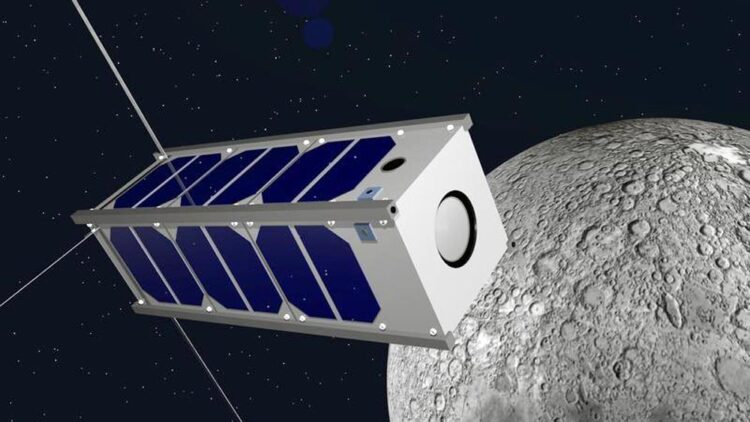Satellites for Missions Far From Earth

Visualisation of a nanosatellite during an extraterrestrial mission in the vicinity of the moon.
Credit: Hakan Kayal / University of Würzburg
What tasks can nanosatellites perform around the moon or even further away from Earth? A new study at the University of Würzburg aims to clarify this.
Satellites for communication, navigation or Earth observation do their rounds in near-Earth orbits. But it is becoming apparent that mankind will soon also be using satellites at greater distances from Earth. Nanosatellites about the size of a shoebox are already being used for lunar missions. They act partly autonomously, but also serve to support larger spacecraft.
“A good example is also the Mars Cube One mission, which consisted of two nanosatellites and supported the landing of the MarsInsight mission in 2018,” says Hakan Kayal, Professor of Space Technology at Julius-Maximilians-Universität Würzburg (JMU) in Bavaria, Germany. In its Artemis programme, NASA wants to take ten nanosatellites to the moon. And the Hera asteroid mission of the European Space Agency (ESA) envisages two nanosatellites accompanying and supporting the mission.
Why are nanosatellites increasingly in demand? For one thing, their technical capabilities are growing, and for another, the cost of transporting them into interplanetary space is falling.
“At present, however, we are still at the beginning of such extraterrestrial missions,” explains Professor Kayal. So far, there are hardly any commercially available components that are suitable for interplanetary missions on board nanosatellites. However, one can assume that this situation will change quickly with increasingly successful missions.
Funding from the Federal Ministry of Economics
That is why Germany also wants to keep an eye on developments in this field and not lose touch. “It seems sensible to systematically investigate the necessary technologies, the challenges, potential goals and benefits of such missions in order to create a solid basis for the use of nanosatellites in extraterrestrial applications,” says the Würzburg professor.
The Interdisciplinary Research Centre for Extraterrestrial Studies (IFEX) at JMU has been entrusted with this task. The new SATEX project will start on 1 October 2022 and run for one year. It is funded by the Space Agency of the German Aerospace Center (DLR) with funds from the Federal Ministry of Economics and Climate Protection (funding code FKZ 50OO2222).
Aims of the new research project
In the SATEX project, Kayal and his team are investigating on a technical-scientific basis which focal points are suitable for the use of nanosatellite missions in extraterrestrial space from the user’s point of view. At the same time, the technical possibilities in the national, European and international framework are systematically analysed in order to be able to evaluate the feasibility of scientific missions with nanosatellites. The results should make it possible to prioritise activities.
In a second step, concrete proposals for possible national missions will then be developed.
The Interdisciplinary Research Centre for Extraterrestrial Studies
IFEX aims in particular to promote the interdisciplinary aspects of extraterrestrial science. It is closely linked to the JMU Professorship of Space Technology and its experience with the construction and operation of nanosatellites (SONATE, SONATE-2).
The technologies being developed at the professorship have long been geared towards operations in interplanetary missions. In this context, the aspect of autonomy by means of artificial intelligence is an important focus – it is of great significance in interplanetary missions due to the long signal transit times.
Wissenschaftliche Ansprechpartner:
Prof. Dr. Hakan Kayal, Space Technology, Chairman of the Interdisciplinary Research Centre for Extraterrestrial Studies (IFEX), University of Würzburg, T +49 931 31-86649, hakan.kayal@uni-wuerzburg.de
Media Contact
All latest news from the category: Interdisciplinary Research
News and developments from the field of interdisciplinary research.
Among other topics, you can find stimulating reports and articles related to microsystems, emotions research, futures research and stratospheric research.
Newest articles

Innovative 3D printed scaffolds offer new hope for bone healing
Researchers at the Institute for Bioengineering of Catalonia have developed novel 3D printed PLA-CaP scaffolds that promote blood vessel formation, ensuring better healing and regeneration of bone tissue. Bone is…

The surprising role of gut infection in Alzheimer’s disease
ASU- and Banner Alzheimer’s Institute-led study implicates link between a common virus and the disease, which travels from the gut to the brain and may be a target for antiviral…

Molecular gardening: New enzymes discovered for protein modification pruning
How deubiquitinases USP53 and USP54 cleave long polyubiquitin chains and how the former is linked to liver disease in children. Deubiquitinases (DUBs) are enzymes used by cells to trim protein…



